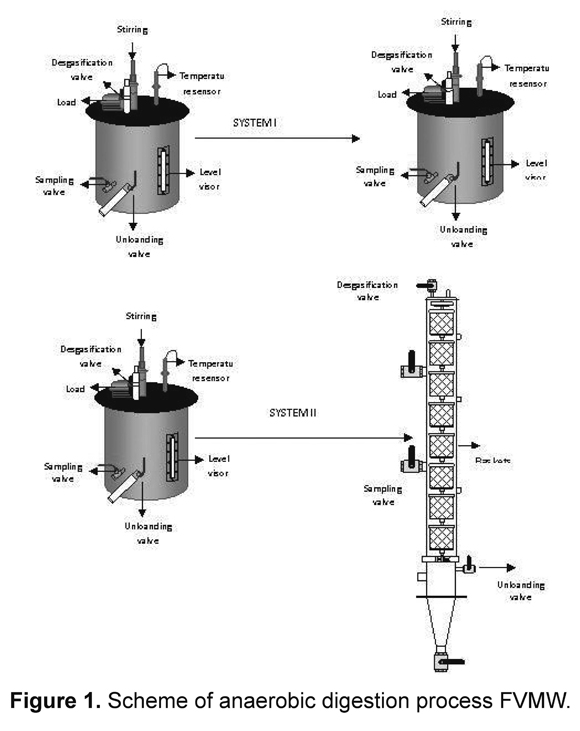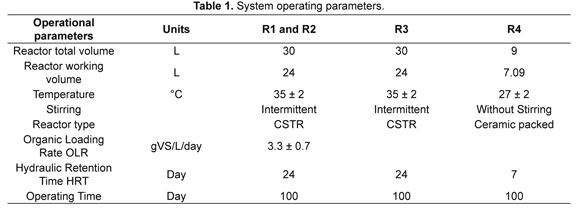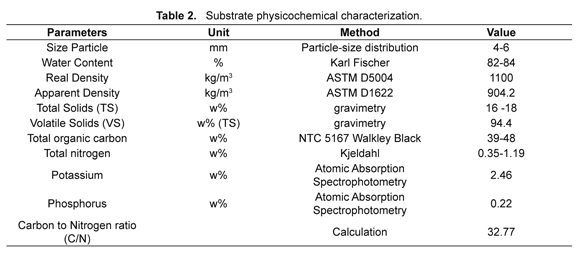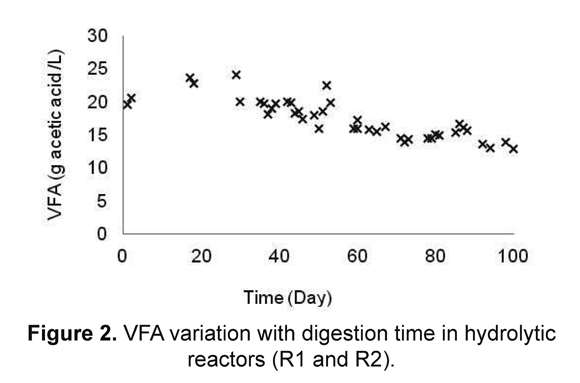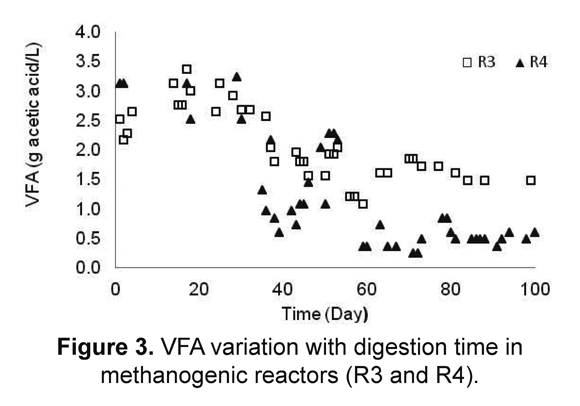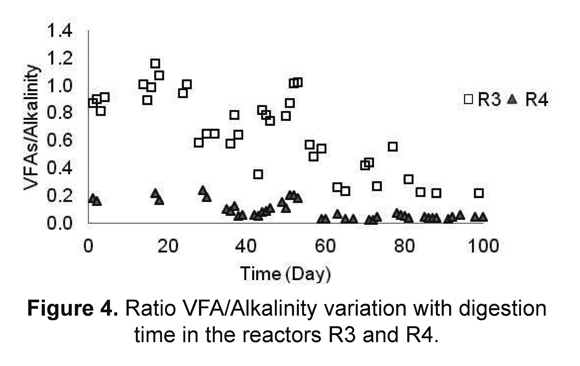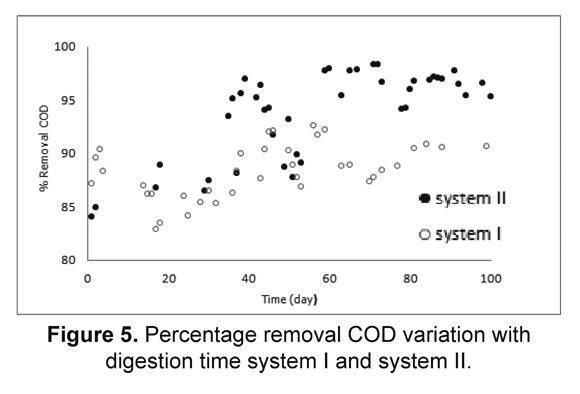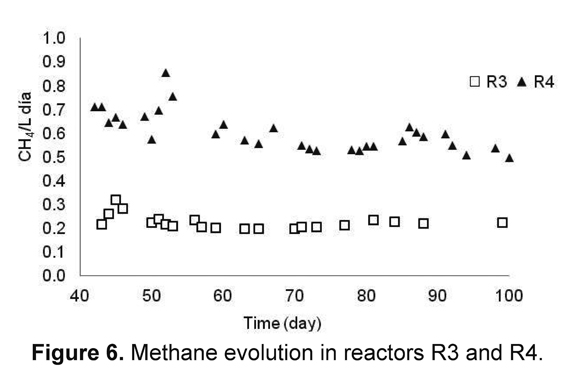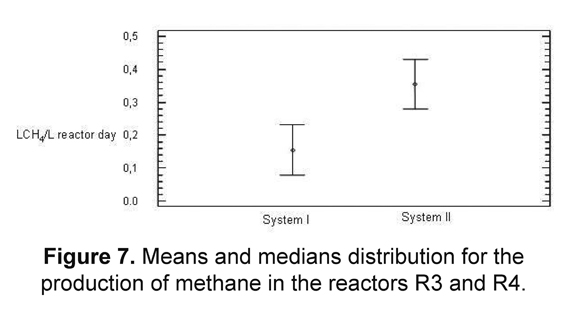Serviços Personalizados
Journal
Artigo
Indicadores
-
 Citado por SciELO
Citado por SciELO -
 Acessos
Acessos
Links relacionados
-
 Citado por Google
Citado por Google -
 Similares em
SciELO
Similares em
SciELO -
 Similares em Google
Similares em Google
Compartilhar
Revista ION
versão impressa ISSN 0120-100X
Rev. ion vol.25 no.1 Bucaramanga jan./jun. 2012
organic fraction of fruit and vegetable municipal wastes treatment
Ligia Patricia Arenas; Humberto Escalante*; Marianny Yajaira Combariza
Centro de Estudios e investigaciones Ambientales - CEIAM, Universidad Industrial de Santander (UIS),
Carrera 27 calle 9, Bucaramanga, Colombia.
*escala@uis.edu.co
Fecha Recepción: 14 de febrero de 2012
Fecha Aceptación: 2 de mayo de 2012
The aim of this study was to evaluate the methanogenic stage of anaerobic digestion to fruit and vegetable municipal wastes (FVMW), by mean of specific design reactors. The evaluation was carried out testing two systems with different configurations. System I was designed by two suspended-bed reactors, one for hydrolytic stage (R1) and other for methanogenic stage (R3). System II was formed by a suspended-bed reactor (R2) for hydrolytic stage and fixed-bed reactor (R4) for methanogenic stage. System I showed instability pH and low methane average production (0.23 ±0.03 LCH4/L/day) in reactor R3, whereas system II showed stable pH, better consumption of volatile fatty acids (VFA) and methane average production of 0.58 ±0.05 LCH4/L/day in reactor R4. Bacterial attachment to the ceramic support surface in the fixed-bed reactor leads to formation a biofilm in system II, and that increases the methane production. For these reasons the system II is the most advisable configuration for the anaerobic digestion to FVMW.
Keywords: fruit and vegetable wastes; anaerobic digestion; bioreactors performance, methanogenic stage, Hydrolytic stage.
digestión anaerobia para el tratamiento de la fracción orgánica
de los residuos municipales de frutas y verduras
En este estudio se evaluó un sistema en continuo de digestión anaerobia para los residuos municipales compuestos por frutas y verduras. La evaluación se llevó a cabo en dos configuraciones de reactores. El sistema I fue diseñado por dos reactores de lecho suspendido (CSTR) para la etapa hidrolítica y para la etapa metanogénica. El sistema II fue conformado por un reactor de lecho suspendido para la etapa hidrolítica y un reactor de lecho empacado para la etapa metanogénica. El sistema I mostro inestabilidad en el pH y baja producción de metano (0,23 ±0,03 lCH4/l/día) en el reactor R3, mientras que el sistema II mantuvo un mejor comportamiento del pH, mejor consumo de Ácidos Grasos Volátiles AGV y una producción promedio de metano de 0,58 ±0,05 lCH4/l/día en el reactor R4. La fijación bacteriana a la superficie del soporte cerámico en el reactor de lecho fijo conduce a la formación de una biopelícula en el sistema II, lo cual incrementa la producción de metano. Por estas razones, el sistema de II es la configuración más conveniente para la digestión anaerobia de FVMW.
Palabras clave: residuos de frutas y verduras, digestión anaerobia, funcionamiento de bioreactores, metanogénesis, hidrólisis.
Anaerobic digestion (AD) is widely recognized as a renewable energy source. The biogas produced in the process is fit for energy production and fossil fuel replacement. Additionally, remnant biosolids can be used as fertilizers or soil conditioners. However, despite all these advantages, nowadays anaerobic digestion has limited applications as waste treatment technology due in part to high costs, low efficiency and technical requirements of the process.
Some impeding issues about the application of anaerobic digestion to organic residues treatment are related to methanogenic microorganisms growing time, multiple inhibitors of the process and biostabilization time, when compared to aerobic processes. Research in this area, though, is very active and several improvements to the process have come forth in the last years [1]. For instance, the use of two-phase anaerobic processes, which separates the hydrolytic and methanogenic steps, allow better efficiencies and biogas yields [2,3]. A major limitation of FVMW anaerobic digestion in a one-stage system is the pH decrease in reactor caused by rapid acidification from VFA production [4]. This effect stresses and inhibits the methanogenic bacterial activity. Two-phase systems indicate higher efficiencies in FVMW anaerobic digestion [5]. On the other hand, a twophase system where a short acidogenic step is followed by a long methanogenic step, often with a separation between the two reactors to withhold particulate matter during the acidogenic step [6], it is considered to be sensitive to high organic load and expensive. Hence operation and control of a two-phase system is considered complicated as acidogenic reactor effluent characteristics (pH, VFA or nutrients) need to be adjusted prior to feeding into the methanogenic reactor [7, 8].
Consequently the successful application of anaerobic technology to organic solid waste treatment depends critically on anaerobic bioreactors optimization and careful control of feedstock physicochemical characteristics [9, 10]. The high reaction rates per volume unit in anaerobic digestion depend of the configuration reactor, the kind of methanizer and the possibility to carry out the process by separating the acidogenic and methanogenic steps [11]. The later is affected when using suspended bed reactors, by the fact that methanogenic bacteria can be washed out with the effluent owing to its long mass doubling times [7]. Thus, currently there is a wide interest in exploring fixed-bed reactors that allow biofilm formation through methanogenic bacteria attached to a solid support. The aim of this study was to evaluate the performance of both systems: a fixed-bed and a suspended-bed reactor; during the methanogenic phase of a two-stage anaerobic process of FVMW.
System setup and operation conditions
The anaerobic degradation process was carried out in continuous operation using four reactors. For the hydrolytic phase we used two identical reactors continuous stirred-tank reactor - CSTR (R1 and R2) with automatic temperature and stirring control and two configurations to methanogenic stage; a CSTR (R3) and a fixed-bed (R4). The reactors R1 and R2 have a volume of 30L and automatic temperature and stirring control. Due the characteristics of FVMW, it was necessary to design a specific agitation system with a helical agitator, moved by a 0.37 kilowatt electric motor. The agitation system was always operated in 2-h intermittent events controlled by a timer. Additional they were equipped with valves to biogas evacuation, feeding, discharging and sampling.
For system I the methanogenic stage was executed in a CSTR-suspended bed (R3) with identical characteristics (R1 and R2). For system II the methanogenic stage was carried out in a fixed-bed reactor (R4). This reactor was loaded with cylindershaped ceramic brick packing distributed evenly in eight baskets along the column [12]. R4 had a volume of 9L and downstream operation (Figure 1). Hydrolytic reactors worked in parallel to continuously produce feedstock for reactors R3 and R4. This setup was designed to ensure uninterrupted system operation. Reactor operating parameters are shown in Table 1.
As raw material for the evaluated AD process was used real mixture of fruit and vegetable municipal wastes. The FVMW was collected from local food markets produced in the city of Bucaramanga, Colombia, using a sampling protocol [12]. The easy biodegradable organic matter content of FVMW (81w%) with high water content facilitates their biological treatment [13]. A size reduction step was necessary to facilitate the handling of the material. Sample homogenization was achieved first by crushing the residues to a particle size of 4 to 6 mm and then by blending them to obtain a slurry. Typical substrate composition was as follows: potato skin 24.1w%, yucca skin 29.51w%, banana skin 16.36w% and vegetables 30w%. Substrate physicochemical characterization is shown in Table 2.
The composition of FVMW is variable and depends, among others, on the source, geographical localization of the market and season. However some literature reports, [14,15] concerning the use of biological treatment for FVMW, give general guidelines for residue characteristics in terms of water content (74 to 90%), VS/TS ratios (80 to 97%), and C/N ratios (14,.7 to 36,4). As it can be gathered from Table 1, FVMW substrate falls within these values and it can be used for the purpose of anaerobic degradation.
Inoculum
In the hydrolytic reactor was used as inoculums a consortium conformed of 1:1 mixture of municipal wastewater treatment plant (MWTP) sludge and pig manure (PM) (Table 3) [16]. The reactors were inoculated with volume amounts of 16.7% from the reactor effective volume.
Then 30 days of hydrolytic reactor operation, a consortium volume was extracted and used as inoculums in methanogenic reactor after a bioestimulation of methanogenic bacteria. To biostimulation a mixture from sterilized residual water, molasses, acetic acid, vitamin B complex, folic acid, micro and macroelements were added to consortium volume. A molasses solution (1%g/mL) was used as carbon source, to start up the process. The mixture was incubated at 38°C for 15 days. Afterwards, it was transfer to 20L reactor in order to increase its microorganism number. Then methanogenic reactors R3 and R4 were inoculated with inoculums of biostimulation of methanogenic bacterium.
Analytical methods
During the two-stage anaerobic digestion run, temperature, pH, VFA, bicarbonate alkalinity and biogas production were measured daily. Chemical oxygen demand (COD) was measured weekly according to the procedure reported in Standard Methods for the Examination of Water and Wastewater [17]. pH measurements were performed with hand-held pHmeter (Hanna Clarkson HI83140, USA), biogas volumetric composition (%O2, %CO2 and %CH4) was determined in situ using a Bacharach GA-94 (Pennsylvania, USA) analyzer suited with an electrochemical cell and an infrared cell of dual wavelength. VFA and bicarbonate alkalinity were determined according to a titration procedure described by Anderson and Yang (1992). The gas volume produced was measured directly by liquid displacement (Mariotte bottle, 5L).
Volatile Fatty Acids degradation of the twostage anaerobic digestion
The Figures 2 and 3 show VFA evolution of production in system I and II. Steady state was reached after 60 days of operation. Hydrolytic stage (R1 and R2) gets at VFA average value production of 17.4g acetic acid /L. These high VFA values indicate that nutrients from FVMW substrate are readily available for metabolic processes. Moreover high production of VFA (40 - 50 g acetic acid /L) should be considered a factor that inhibits hydrolysis stage. Therefore, VFA concentration is an important factor when optimizing the efficiency of anaerobic digestion processes of complex substrates [18, 19].
VFA's concentration in R3 and R4 was high during the first sixty days of continuous operation while reactors reached the steady state. After this initial period VFA concentration values decreased in both reactors, and obtained an average value of 1.7g acetic acid /L and 1.2g acetic acid /L for R3 and R4 respectively. The different levels of VFA concentration between hydrolytic and methanogenic stage show good achievement of consortia methanogenic bacterium presents in the inoculums used in this study. The concentration of TVFA has been found to be a very good indicator of the metabolic status of an anaerobic degradation process. A FVMW biomethanization study, with 20% and 30% total solid content, shows maximum VFA concentrations of 2.3 and 2.7g/L system inhibition by VFA [20].
The optimal working pH for hydrolytic stage in anaerobic digestion is between a range from 5 to 6 [4, 16, 18, 19]. In this study pH variation in R1 and R2 oscillated between 4.6 and 5.5. The pH behavior of R1 and R2 was according to hydrolytic stage, this circumstance is a consequence of high VFA formation and low alkalinity. During R1 and R2 operation time, the pH was not needed specific control; such a condition shows good development metabolic of inoculums.
The methanogenic bacterium requires, for its optimal metabolic activity, a working pH within a range from 6.5 to 8 [21]. In this research pH was average value of 6.87 and 7.58 to R3 and R4 respectively; without specific control. It is essential that the reactor contents provide enough buffer capacity to neutralize VFA accumulation, [22]. The pH value constant in methanogenic stage demonstrates excellent achievement of consortia presents in the inoculums used in this work.
Additionally, the average values of partial alkalinity were 4.1 and 2.6g/l for R3 and R4 respectability. Laboratory studies about mesophilic and thermophilic anaerobic organic wastes digestion reported a range of 2 - 4g/L partial alkalinity as being typical for properly operating digesters]. Furthermore the VFA/alkalinity ratio (shows Figure 4) did not rise above the critical value of 0.4; this condition is beneficial for increasing gas production and for stabilizing the digestion process [23, 24].
COD analysis of the two-stage anaerobic digestion
COD removal is an important indicator of biomass transformation into methane by microorganisms. Output average values for COD in systems I (R1 and R3) and II (R2 and R4) were 15.2 and 4.2gO2/L and percentage removals COD an average of 89% and 98% respectively (Figure 5). Values COD decreased as a function of the digestion time. However, the present biomass in this stage warrants a good hydrolytic development, similar to other studies [15, 23].
COD removal is an important indicator of biomass transformation into methane by microorganisms. For instance, it has been reported 96% of the total COD was converted to biomass and biogas from fruit and vegetable wastes using a twostage anaerobic digestion. In this study, system I performs very well and reaches COD removal values close to the highest reported in literature [21]. It is obvious than the presence of a solid support in R4 ensures an efficient transformation of the feed, when compared to the R3 suspendedbed reactor.
Methane analysis of the two-stage anaerobic digestion
Both reactors R3 and R4 had good stable methane production during operation time (Figure 6). This high performance and stability of system I and II could be due to positive synergism of consortia and an optimal balance of nutrients in the medium digester. Average methane production in R2 and R3 of 0.23 LCH4/L reactor day and 0.58 LCH4/L reactor day respectively; these results were according with others researches. For example, in a biogas production process with a typical HRT of 15-30 days, only 50 -70% from organic matter is converted into methane [23, 24].
The volumes of methane production in system I and system II were 0.23 ±0.03 LCH4/L and 0.58 ±0.05 LCH4/L reactor per day for R2 and R3 respectively. These values were according with the results of two stage anaerobic digestion of fruits and vegetables; with methane volume of 0.26 to 0.74 LCH4/L/day from organic loading rate of 3.7 a 10g COD/L/day [21]. The results in this work allow infer that a fixed bed reactor (R3) affords better biomass transfer formation into biogas than a suspended-bed reactor. It is approach, R3 is efficient, easy to handle (if key parameters are monitored), and produces good methane yield. In summary, despite the low pH of the hydrolic feed (4.6 - 5.5), this parameter in R3 increased up to its neutral value (between 7 and 8.45) because of the process stability and the activity of methanogenic bacteria of the inoculum.
Statistical analysis
In order to determine whether the observed differences between digesters performances data were subjected to the ANOVA tests (Statgraphics Inc, 2007). Figure 7 shows that there is difference statistically significant between the behavior two systems in relationship with methane production (P <0:05).
These processes differ mainly in the way that microorganisms are retained in the bioreactor, and the separation between the acidogenic and the methanogenic bacteria which reduce the anaerobic digestion limitations.
A fixed-bed reactor for methanogenic phase of fruit and vegetable municipal waste' anaerobic digestion is better than a suspended bed reactor.
The fixed-bed reactor showed good pH stability and VFA/alkalinity ratios with methane volume 0.58 ±0.05 LCH4/L reactor day. The methanogenic bacteria have long mass doubling times and should stay for long time into reactor. For this reason, the fixed bed reactor allows the immobilization of biomass in an inert support and improve the methanogenic phase.
Thence it is possible to conclude that separation phase between two groups of micro-organism involved in anaerobic digestion it is necessary to improve the yield of total process.
Authors gratefully acknowledge the financial support given by COLCIENCIAS, a government institution that promotes science in Colombia, and CEIAM-UIS (Centro de Estudios e Investigaciones Ambientales - Universidad Industrial de Santander) for academic support.
[1] Rapport J, Zhang R, Jenkins BM, Williams RB. Current Anaerobic Digestion Technologies Used for Treatment of Municipal Organic Solid Waste. California: Department of Biological and Agricultural Engineering, University of California, Davis; 2008. [ Links ]
[2] Borzacconi L, Lopez I, Viñas M. Application of anaerobic digestion to the treatment of agroindustrial effluents in Latin America. Water Science and Technology.1995;32(12):105-11. [ Links ]
[3] Mata A, Macé S, Llabrés P. Anaerobic digestion of organic solid wastes. An overview of research achievements and perspectives. Bioresour. Technol. 2000;74(1):3-16. [ Links ]
[4] Landine RC, Brown GJ, Cocci AA, Virara H. Anaerobic treatment of high strength, high solids potato waste. Agric Wastes. 1983;7(2):111-23. [ Links ]
[5] Raynal J, Delgenes JP, Moletta R. Twophase anaerobic digestion of solid wastes by a multiple liquefaction reactors process. Bio Technol. 1998;65(1-2):97-103. [ Links ]
[6] Demirel B, Yenigun O. Two-phase anaerobic digestion process: a review. J Chem Technol. Biol. 2002;77(7):743-55. [ Links ]
[7] Sachs JV, Meyer U, Rys P, Feitkenhauer H. New approach to control the methanogenic reactor of a two-phase anaerobic digestion system. Water Res. 2003;37(5):973-82. [ Links ]
[8] Babel S, Fukushi K, Sitanrassamee B. Effect of acid speciation on solid waste liquefaction in an anaerobic acid digester. Water Res. 2004;38(9):2416-22 [ Links ]
[9] Weiland P. One and two-step anaerobic digestion from the organic fraction of municipal solid waste. Water Sci Technol. 1993;27(2):145-51 [ Links ]
[10] Lissens G, Vandevivere P, De Baere L, Biey EM, Verstrae W. Solid waste digesters: process performance and practice for municipal solid waste digestion. Water Sci Technol. 2001;44:91-102. [ Links ]
[11] Vandenberg L, Kennedy KJ. Comparison of advanced anaerobic reactors. In: Proceedings of the 3th International Symposium of Anaerobic Digestion; Boston. 1983. [ Links ]
[12] Martinez G, Rodriguez C, Castillo E. Diseño y construcción de un biodigestor anaerobio de lecho fijo para operación en continuo a escala piloto con control de temperatura y pH (trabajo de grado) Bucaramanga, Colombia: Universidad Industrial de Santander; 2007. [ Links ]
[13] Viturtia A, Mata J, Cecchi F, Fazzini G. Two-phase anaerobic digestion of a mixture of fruit and vegetable wastes. Biol Waste. 1989;29(3):189-99. [ Links ]
[14] Rao M, Singh S. Bioenergy conversion studies of organic fraction of MSW: kinetic studies and gas yield-organic loading relationships for process optimization. Bioresour. Technol. 2004;95(2):173-85. [ Links ]
[15] Traverso P, Pavan P, Bolzonella D, Innocenti L. Acidogenic fermentation of source separated mixtures of vegetables and fruits wasted from supermarkets. Biodegradation. 2000;11(6):407-14. [ Links ]
[16] Castillo E, Cristancho D, Arellano V. Study of the operational conditions for anaerobic digestion of urban solid wastes. Waste Manage. 2006;26(5):546-56. [ Links ]
[17] APHA, AWWA, WPCF. Standard methods for the examination of water and wastewater. 19th ed. Washington, DC: APHA, AWWA, WPCF; 1995. [ Links ]
[18] Vavilin VA, Fernandez B, Palatsi J, Flotats X. Hydrolysis kinetics in anaerobic degradation of particulate organic material: An overview. Waste Manage. 2008;28(6):939-51. [ Links ]
[19] Veeken A, Kalyuzhnyi S, Scharrff H, Hamelers B. Effect of pH and Hydrolysis of Organic Solid Waste. J Enviro Eng. 2000;1076-81. [ Links ]
[20] Fernández J, Pérez M, Romero LI. Effect of substrate concentration on dry mesophilic anaerobic digestion of organic fraction of municipal solid waste (OFMSW) Bioresour. Technol. 2008;99(14):6075-80. [ Links ]
[21] Converti IA, Del Borghi A, Zilli M, Arni S, Del Borghi M. Anaerobic digestion of the vegetable fraction of municipal refuses: mesophilic versus thermophilic conditions. Bioprocess Biosyst. Eng. 1999;21(4):371-6. [ Links ]
[22] Neves L, Oliveira R, Alves M. Influence of inoculum activity on the bio-methanization of a kitchen waste under different waste/inoculum ratios. Process Biochem. (Oxford, U. K.). 2003;39(12):2019-24. [ Links ]
[23] Bouallagui HM, Torrijos JJ, Godon R, Moletta R, Ben C, Touhami JP, et al. Two-phases anaerobic digestion of fruit and vegetable wastes: bioreactors performance. Biochemical Engineering Journal. 2004;21(12):193-7. [ Links ]
[24] Demirer G, Chen S. Two Phase anaerobic digestion of unscreened dairy manure. Process Biochem. (Oxford, U. K.). 2005;40(11):3542-9. [ Links ]













